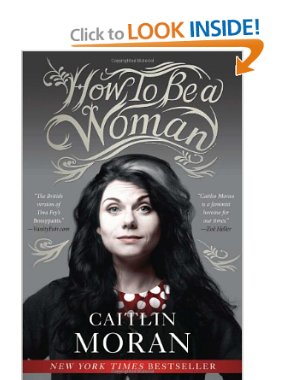“How to Be a Woman” by Caitlin Moran
A few months ago, my husband was reading something on his nook and kept laughing aloud. It was Caitlin (pronounced CAT lin) Moran’s How to Be a Woman, which he’d seen recommended by gonzo author Warren Ellis. Since his copy was an e-book, he got a hard copy for me (I’m a traditionalist, and yes, I’ve tried e-readers. Not my cuppa.)
Starting off, it reminded me a lot of Jenny Lawson’s Let’s Pretend This Never Happened because it’s about growing up poor and weird far from a major city. While Lawson’s is a pretty straightforward memoir, Moran’s is personal stories pinned up around a theme of what she refers to as strident feminism, a term she knows will put some people off. And yet, she has two diagnostics that I thought were useful and to the point.
One, to tell if you’re a feminist:
a. do you have a vagina? and
b. do you want to be in charge of it?If you said yes to both, then congratulations! You’re a feminist. (p. 75)
Another,
how can you tell when some sexism is happening to you?
Well, in this matter, what ultimately aids us is to simply apply this question to the issue: Is this polite?
The anecdotes come fast and funny, and it’s entertaining and a good reminder of other things that I, at least, sometimes forget. On underwear:
I’m pro big undies. Strident feminisms NEEDS big undies…there is scarcely a woman in Britain wearing a pair of underpants that actually fit her. Instead of having something that sensibly and reassuringly contains both the buttocks–what I would call a good pair of undies–they’re wearing little more than gluteal accessories, or arse-trinkets. (91-2)
On high heels:
“But, bafflingly, we totally accept the uselessness of heels. We accept it limply, shrugging. We are indifferent to the thousands of pounds we spend over a lifetime on shoes we only wear once, and in great pain. (196)
On bras:
“a good bra can be one of the greatest aids a woman will ever know.” (95)
(The only kind of bras she burns are the ones that don’t fit properly.)
There is also a very thoughtful and thought-provoking chapter near the end on a topic so touchy that most wouldn’t touch it, but Moran does, politely, I thought.
BUT. Here come the but’s. Somewhere around the middle of the book, when the childhood anecdotes stopped and the book became more straightforwardly a treatise on feminism, I became less engaged. Moran made huge sweepting statements and didn’t qualify them, e.g., How to Be a Woman, right up front there in the title. Nowhere does she qualify her position as a non-poor white woman. See also:
“Even the most ardent feminist historian, male or female–citing Amazons and tribal matriarchies and Cleopatra–can’t conceal that women have basically done fuck-all for the last 100,000 years. Come on–let’s admit it.” (131)
Um, no. No. I will not admit that.
Also, she draws a polar distinction between burlesque, saying that it lets “the power balance rest with the person taking her clothes off”, as opposed to strip clubs, which she finds indefensible. I don’t quite buy either extreme of her argument.
She offers two chapters: Why You Should Have Children and Why You Shouldn’t Have Children. But while it seems balanced that she included the latter, her romantic waxing on motherhood tip the scales toward the former. Additionally, this was one of many instances in which she used “you” rather than “me” and I found the slippage into second person grating, as when she keeps using “you” in the chapter about naming her vagina and breasts, which is not something I ever did or worried much about. And I was bothered by her use of “you” in the chapter on abortion. She probably did it as a way to draw in the reader and encourage empathy, but it came off to me as distancing herself from her own story.
In the end, the amusing anecdotes and helpful reminders were not enough to win me over. I spent some time reading reviews at Goodreads, and there are almost no three star reviews–they tend to 1/2 hate or 4/5 love. I would give this book 3 stars. Some good stuff, some not good stuff. Context and qualificaiton would have made a huge difference to me. Enough good stuff for a qualified recommendation, but that’s it.
